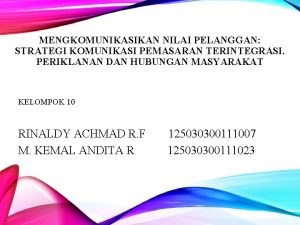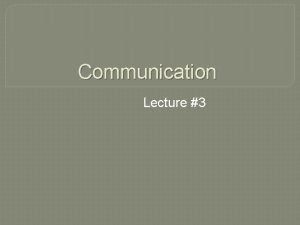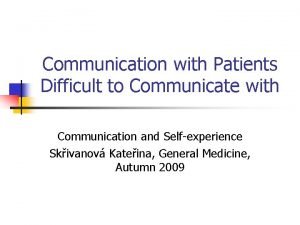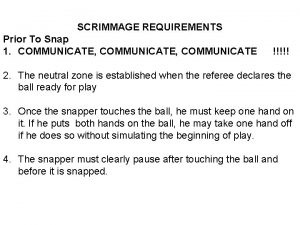Communication with Patients Difficult to Communicate with Communication











- Slides: 11

Communication with Patients Difficult to Communicate with Communication and Self-experience Skřivanová Kateřina, General Medicine, Autumn 2009

General Recommendations n n Find out the case history, ask about quality of contact with the previous doctor and learn a lesson from it The doctor controls the development of the situation The doctor accepts the patient and expresses them support and understanding The doctor puts emphasis on therapeutic contract

Mentally Retarded Patient n n n The patient reacts sensitively to the emotional condition of the doctor. Avoid impatient, reserved, unconfident, agressive and anxious behaviour Communicate primarily with the patient, the accompanying person only specifies the information The basis of cooperation is a positive emotional response to the patient, appreciation of his/her effort, thorough and patient explanation of the examination procedure, medical report and further treatment

Blind Patient n n n Communicate primarily with the patient Describe what you are going to do and how Always inform in advance about a medical intervention and why it is necessary Rearrange your consulting room, remove obstructions and barriers Create acoustically reasonable environment Avoid expressing pity

Hard of Hearing Patient n n n Articulate clearly, speak slowly Ask Check carefully your as well as the patient‘s non-verbal communication Be patient Appreciate the patient, even non-verbally In case of problematic communication ask an interpreter for help

Agressive Patient n n Explore motives of the patient‘s agressive behaviour (e. g. As an expression of the phase of acceptance of the illness) and act carefully according to their judgement, do not let yourself get impulsively into a conflict Deal with the patient in compliance with the assertiveness rules, possibility of using the retreat/confrontation model n Combination of an agressive and anxious patient – anxious pedant with ambivalent behaviour

Anxious Patient n n They demand feeling of safety and certainty, reassurance and support. It is the doctor‘s duty to reduce the patient‘s anxiety Anxiety is accompanied by adrenergic (sympathicotonic) activity During an illness the patient suffers from lose of control. They feel ashamed and vulnerable when they are weakened The doctor gains trust by using a scientific approach with a thorough collection of anamnestic data, patient listening

Depressive Patient n n n A depressive patient shows irreparable sad mood, powerlessness and hopelessness, lack of energy and life perspective In case of suicidal tendencies it is neccessary to open up the topic, anti-suicidal contract Appeal to patient‘s strong will makes things worse

Narcissistic patient n n Desires to be looked after. Their illness represents secondary gaining of attention. They represent their problems as unique and special. If they do not receive an “adequate“ care, they get angry = complications in care = interruption. It is possible to use their selfadmiration for treatment purposes. The doctor should set clearly his proposal and possibilities. He should motivate the patient by continuous appreciating their cooperation.

Paranoid patient n n n Upon contact with the doctor during the illness the following appears: distrust, hypersensitiveness to humiliation, fear of dependence, intensified feelings of embarrassment and vulnerability Be prepared for: exaggerated reaction to undesirable effects of medication, painfulness of intervention, unkind approach of the doctor, accusing of malpractice, lack of qualification of the doctor Contact can be helped by: objective, friendly contact without jovial or intimate approach, timely information (about side effects), patient and kind facing the hostility of the patient suffering from distrust and fear

Sources n n Vymětal, J. Lékařská psychologie, Psychoanalytické nakladatelství, 1999 Honzák R. , Komunikační pasti v medicíně. Galén, 1977. Tate P. Příručka komunikace pro lékaře. Praha, Grada, 2005 Hájek K. Práce s emocemi pro pomáhající profese. Praha, Portál, 2007.
 Why communicate
Why communicate How do people communicate
How do people communicate Actg 2p12
Actg 2p12 How do processes communicate
How do processes communicate To inform entertain persuade
To inform entertain persuade Mengkomunikasikan nilai adalah
Mengkomunikasikan nilai adalah Effectively communicate meaning
Effectively communicate meaning Examples of ipc systems
Examples of ipc systems Scout and aunt alexandra communicate very poorly
Scout and aunt alexandra communicate very poorly Globalsubmit communicate
Globalsubmit communicate Fractir
Fractir When we communicate verbally we should use
When we communicate verbally we should use





















